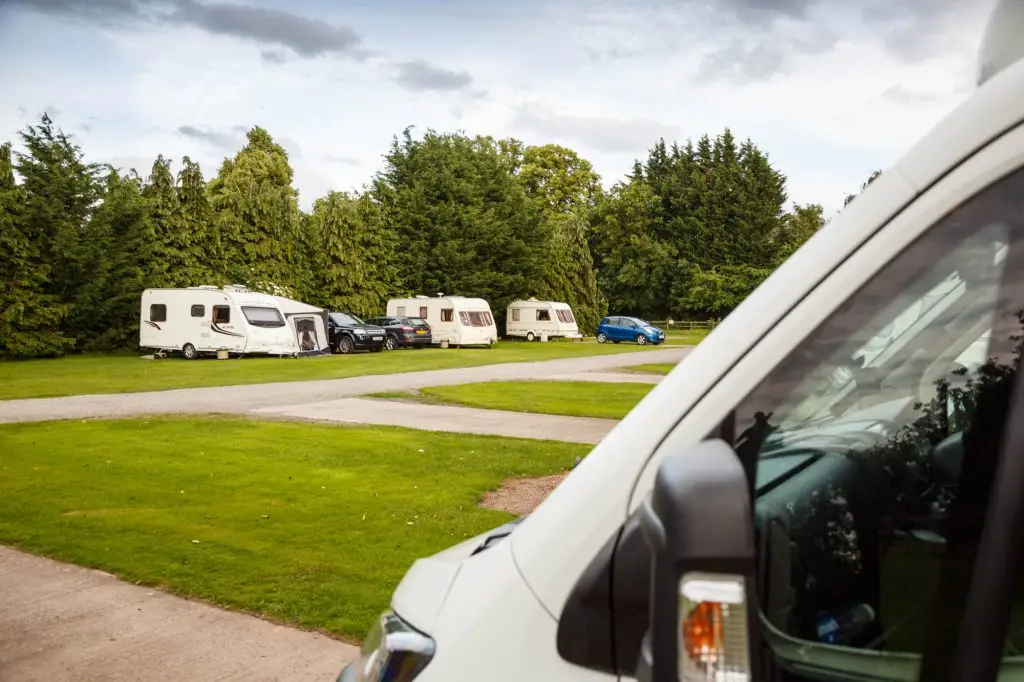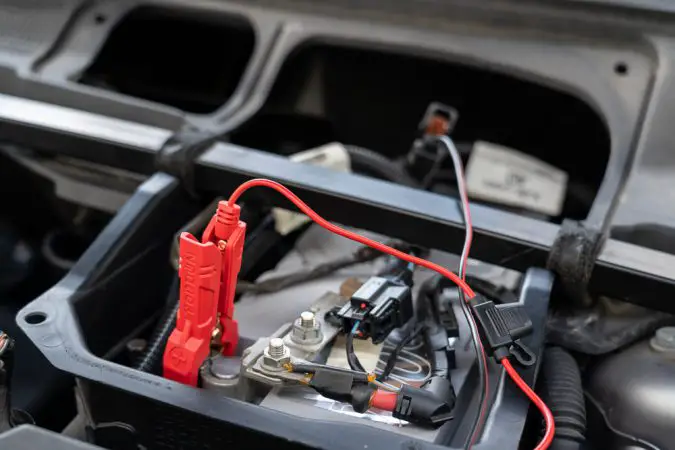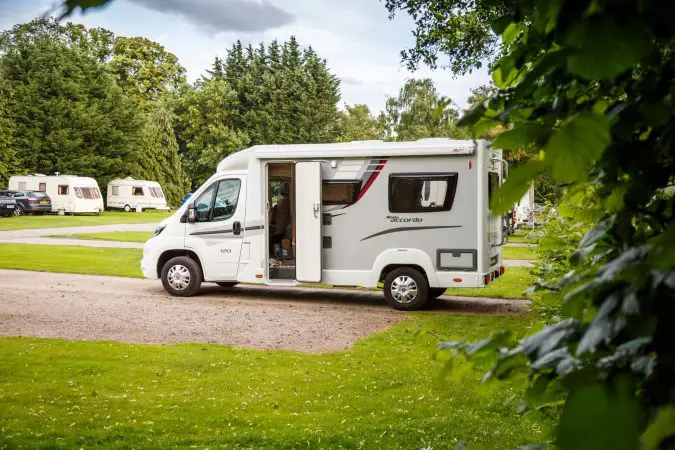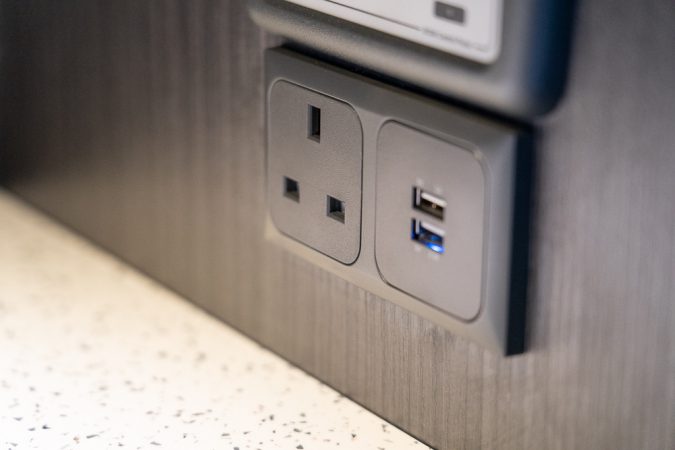While camping out in nature is nice, it’s even nicer when you can bring your electrical appliances with you and make life in nature just that little bit easier. That’s kind of like the entire idea of RVs. But will your 50 Amp RV plug work? Will you need adapters? What else should you know?
While your RV may have a 50 Amp service, many campsites don’t have 50 Amp receptacles or power pedestals. Or maybe it’s the other way around for you, and you’ll need to figure out all this electrical nonsense to power your RV.
That’s what we’re going to guide you in this post. We’ll delve deeper into the world of RV power, and answer everything you may want to know about the 50 Amp RV Plug, and everything else about your RV’s electricals:
50 Amp RV Plug: Basics Of RV Electrical
If you’re an experienced RVer, you won’t need us to tell you about the basics. In which case, you can use our table of contents above to navigate through the article and find the information you need. But if you’re new to the world of RVs, let’s learn the basics first.
Your RV has two electrical systems: a 12-volt DC electrical system. This is a battery (or sometimes multiple batteries) that your RV uses to start the engine. Additionally, it’s often used for powering basic appliances such as the lights, fridge, and other basic features of the vehicle.
The second system is a 120-volt AC system. This is the system that’s powered by an electrical plugin or a generator. This can power more power-demanding appliances such as a microwave, TV, and air-conditioning.
To use the 120-volt AC system, you’ll either need to turn on the generator or plug it into a power source. To meet our modern power demands, most new RVs come with a 50 Amp service. However, some will still have 30 Amp service, and older ones are even lower at 15 Amps.
As you’d expect, the lower the Amp service, the fewer appliances it can support. And there are a couple more key differences that you should keep in mind, along with everything else you need to know:
50 Amp RV Plug: Key Differences With 15 And 30 Amps
The first key difference is in the design. Both 15 and 30 Amp receptacles (that’s the female plug or socket) will have three slots. As for the male plug, it will have two long prongs on the bottom and a shorter one above that acts as the ground.
Meanwhile, a 50 Amp RV plug has a total of four prongs. Two of them are hot wires, and the other two are neutral wire and ground wire. And that’s about it in terms of physical difference.
The other difference is, of course, the amount of electricity it supplies and therefore the appliances you can run. A 15 Amp service will supply 1,800 watts, while a 30 Amps supply 3,600 watts. Meanwhile, an RV with a 50 Amp service will supply you with a whopping 12,000 watts.
This means you’ll have to be wary of what you plug in when you have an RV with a lower Amp service. But if your RV has a 50 Amp service, you can plug in pretty much almost every electrical appliance you fancy simultaneously.
Since the plugs are different, it’ll be a good idea to enquire with the campsite where you’ll be staying to see the Amp-rating of their receptacle. This will also allow you to manage your expectation on how many electrical appliances you can plug in.
We know what you’re thinking, can you plug a 50 Amp RV into a 30 Amp receptacle and vice versa? Well, let us answer your questions in our next section:
50 Amp RV Plug: Plugging Into A Different Amp Receptacle
So, can you plug a 50 Amp RV into a 30 Amp receptacle? The short answer is yes you can. This is good since a 50 Amp power pedestal isn’t always readily available at campsites. But of course, you’ll need an adapter to do so since the plugs have different designs.
However, keep in mind that this doesn’t change the amount of power you receive. This means your RV will receive 30 Amps or 3,600 watts of power tops. So, while your RV can support more, you’re limited by the power supply and you’ll have to be aware of what you plug in and use.
Can I Plug My 30-Amp RV To A 50-Amp Power Pedestal?
You can as well, as long as you use a good adapter. Some RV drivers worry that the extra power will fry the RV’s electrics, but you’ll be okay as long as you use a good adapter. Since the adapter will still only deliver a maximum of 30 Amps to your RV.
Of course, this means that you will only still be able to use a maximum of 30 Amps or 3,600 watts in your RV. You won’t be able to use the full 50 Amps that the receptacle is providing. So, make sure you still keep an eye on what you’re plugging and using in your RV.
How About Plugging Into A 15-Amp Pedestal?
The same goes if you’re plugging into a 15-Amp receptacle. Whether you have a 30-Amp or 50-Amp service RV, you can use a 15-Amp receptacle. With the help of an adapter, of course.
Again, your RV’s power is limited by the power source. If you have a 30-Amp RV plugging into a 15-Amp power source, you’re getting a maximum of 15 Amps.
How To Use Adapters And Setup Your RV
In case you’re new to RV life, we’ll give you a quick guide on how to set up your RV at the campsite. Specifically, how to wire your RV and bring power to it. Here’s the quick guide:
- Switch off your RV’s main circuit breaker.
- Connect your power cord to the RV and tighten the collar. If it’s already plugged in, then pull out the cord.
- If necessary, plug the adapter onto the RV’s power cord.
- Before plugging the cord in, make sure that the receptacle’s circuit breaker is off as well.
- Once off, plug the RV’s power cord into the receptacle. Tighten the collar if the plug has it to make it weatherproof.
- Switch on the circuit breaker on the receptacle, and then on your RV. You now have power for your RV.
- When you’re done, switch off all the circuit breakers before unplugging the RV’s power cord.
The key thing when setting up your RV’s electricity is to turn off the circuit breakers first. This prevents power surges from damaging your RV’s electrical system, and for your safety as well.
Precautions On Using Adapters
This goes without saying but the first thing you should note is of course paying attention to the appliances you’re using when plugging into a receptacle with lower power output. It could be easy to forget that you’re using a lower-powered receptacle if you’re used to having 50 Amps in your RV.
Using more power than available will not only bog down your RV but the campsite’s electrical system as well. Additionally, it’s possible that the receptacle’s breakers won’t trip when you’re using electricity excessively.
If the receptacle’s breaker doesn’t trip, it will burn up and become unusable; likely upsetting the campsite owner afterward. Getting berated by the campsite owner isn’t exactly high on anyone’s holiday to-do list.
The next thing you should pay attention to is the physical condition of the plugs on the adapters themselves. Especially if you’re plugging into a more powerful receptacle than your RV can receive.
The excess power can cause the adapters to overheat, resulting in burnt plugs. Needless to say, burnt plugs are no longer safe to use. At best it won’t work or you’ll have a power surge, at worst it can catch fire or electrocute you resulting in some very expensive repair and hospital bills.
Follow the precautions above and you should be fine and you’re off to a good holiday with your RV regardless of the power output available at the campsite. However, you’ll still need to pick a good adapter, which brings us to our recommendations:
RV Cord Adapter Recommendations
As the video above shows, there are two main types of adapters: plugs and dogbones. Plugs are, well, plugs. You attach it to the end of your RV’s power cord, and you’re good to go.
Dogbone adapters are similarly simple, but they have a cable that runs between the female plug (for your RV) and the male plug (for the receptacle). This makes it look like those bones that dogs chew in cartoons (speaking of, check out our overview of what kinda car is Lightning McQueen), hence the name dogbone.
Neither has any particular advantage, apart from dogbones adding an extra 12 to 18 inches to the total length of your RV’s cord. RV enthusiasts seem to love dogbone more and they’re a bit more popular. However, the extra cable length means there’s more cable that’s susceptible to moisture intrusion and electrical corrosion.
So, which type is better? The answer will depend on who you ask. In the end, it’s a matter of preference. And the key thing is to pick a quality product that will keep you and your RV safe. Here are our recommendations that you can consider:
1. Best Dogbone Adapter: Camco Heavy Duty Power Grip Adapter
The Camco Power Grip adapter seems to be the favorite among RV enthusiasts. Everywhere we look, there are recommendations for this, and it’s often regarded as the best adapter you can find.
It’s available as a 50-Amp to 30-Amp, 30-Amp to 50-Amp, and either 30-Amp or 50-Amp into 15-Amp. There are several more specs, and prices vary depending on which one you’re getting. But it ranges from $12.99 to $68.49. Don’t worry, it’s often on sale and you can pick them up for cheaper.
Whichever spec you need, we recommend getting ones with both the 90-degree angle and a locking mechanism if possible. The 90-degree angle of the male plug will reduce strain and help the cable to last much longer.
Meanwhile, the locking mechanism or the collar will make the plug weatherproof. Ensuring that no moisture gets in and short-circuiting the plug.
If you’re taking a look at the product page, here’s a quick tip so you don’t get confused: if the variant says “15M/30F”, this means the adapter will adapt a 30-Amp RV cord into a 15-Amp plug. The same goes for the following products:
2. Best Adapter Plug: Camco Power Grip Electrical Adapter
Since Camco makes the best dogbone adapter, it’s only natural they make the best adapter plugs as well. The Camco Power Grip adapter plug has a contoured grip making it easier to, well, grip. Of course, this helps in removing the plug from the socket.
If you don’t fancy the dogbone adapter, this is for you. Additionally, it’s cheaper than dogbone adapters and costs less than $10 except for the generator adapters.
Unfortunately, some of them don’t come with locking plugs. Meaning they won’t be weatherproof. If you want the weatherproof version of the plug, you’re going to have to shell out around $25. Additionally, the 50-Amp capable variant is only available with the locking plug connection.
3. Amazon Best Seller: RVGuard Adapter Cord
The RVGuard dogbone adapter is technically the second best-selling product on Amazon. However, it’s our pick since it has more positive reviews than the number one product.
The RVGuard is available in several variants, including 30-Amp to 15-Amp, 50-Amp to 15-Amp, and 50-Amp to 30-Amp amongst others. The adapter is available with either a locking connector for the RV cord or a normal handgrip.
However, the 30-Amp to 50-Amp variant isn’t available with a locking connector. It also has a green LED indicator to tell you whether it’s transferring power or not, something the Camco doesn’t have.
The downside is that most of the variants don’t come with a 90-degree design for the plug to reduce strain. So, if you prefer that, you might want to take a look at the Camco again.
With 85% of the ratings being a five-star rating, this is certainly a good product. The negative reviews that we found are mostly because of either the cable angle or Tesla owners being angry that this doesn’t charge their Tesla.
To be fair, yes, the product page does claim it can charge an EV. But it seems that EV owners – Tesla in particular – are having issues. But if you’re using this for an RV, you’re good to go.
4. Extra Power: Camco PowerGrip Maximizer
This one from Camco is quite unique, as the plug has two male ends. One that connects to a 30-Amp plug, and another one to a 15-Amp plug. This allows you to draw a total of 45-Amp if you can connect both ends simultaneously.
It’s quite expensive at around $73, but it is unique and potentially useful if you have a 50-Amp service RV. But can you use just one of the plugs and leave the other one connected? The product page suggests you can, but it’s quite risky since you’ll be leaving the other plug exposed to the elements.
Additionally, the adapter will not work with GFCI/GFI circuits. So, keep that in mind, but it’s quite an interesting product that saves you the need of buying two different adapters.
5. If You Need A Power Cord: Leisure Cords Power Extension Cord
In case you need it, we’re recommending the Leisure Cords Power/Extension Cord if you need a power cord or an extension for your RV. It’s available in either 25 or 50-foot length for the 30-Amp variant, but the 50-Amp variant tops out at just 15 feet, unfortunately.
Nevertheless, it has a locking power cord, and LED power indicator, and costs a reasonable $59. The manufacturer also claims “marine-grade quality material.” Make of that what you will, we tend not to believe marketing language such as this, but if the reviews are anything to go by, it’s a good cord regardless of the claim.
An honorable mention goes to the Camco PowerGrip Extension Cord, which is also very good and durable. Much like Leisure Cords, it also has a 90-degree plug and a locking adapter. However, they’re more expensive at around $92 and tops out at 25 feet in length.
50 Amp RV Plug: Questions & Answers
Got any more questions about your RV’s electrical system? We’ll answer some common questions below:
Do I Need A Surge Protector?
You don’t need it until you do. It depends on your risk tolerance for this one, but we generally recommend getting a surge protector just to be safe.
A power surge is a spike in electrical current that lasts more than three nanoseconds. This extra power can cause problems to your RV’s electronics and appliances that are plugged in. The surge protector will divert this power, protecting your RV.
Most surge protectors will cost somewhere between $90 – $250 depending on their protection level. If you want to splurge, Surge Guard from Southwire costs $419 apiece.
In addition to the surge protection, it also has an automatic reset with a 128-second delay. This delays the return of power, ensuring that the power supply has stabilized before feeding power back to your RV and protecting your A/C compressor.
One thing to keep in mind about these surge protectors is that we’ve seen reliability issues with them in the reviews. While reviews are mostly positive, some devices break immediately after a power surge rendering them useless, and others have weather protection issues. We’re seeing this sort of review in every product that we can find, even in the ever-so-popular Camco, so be wary of that.
Do I Need A 30-Amp Or 50-Amp Surge Protector?
Bottom line, you’ll want to match your RV’s Amperage. If you have a 30-Amp service RV, then use the 30-Amp surge protector. If you have the 50-Amp service RV, then you’ll want the 50-Amp surge protector. Regardless of the power output of the receptacle you’re connecting to, it’s a safe idea to use a surge protector that matches your RV’s Amp rating.
Can I Plug My RV Into My Home?
Yes, you can. Whether you want to live in your RV for a couple of days as an experiment, get away from your spouse, or whatever other reason, you can. You’ll need to buy an adapter for a 15-Amp socket, and you’re good to go.
Plugging in your RV from time to time is a good idea since it will charge your RV’s battery and prevent the battery from going flat. This is assuming your RV is fitted with a power converter since the two systems are separate. If not, you’re going to have to fit a power converter into your RV.
A more ideal scenario is to install an outlet dedicated to your RV at home. This means your RV gets the full 30 or 50 Amps it requires (depending on the outlet you install).
This is of course not an easy task, and unless you’re familiar with electronics, we don’t recommend doing this yourself. You can have an electrician do it for you and it’ll cost somewhere between $425 – $1,200 in total.
Do I Need A Generator In My RV?
If you travel to designated campgrounds, it’s not going to be of much use since you can get power from the campgrounds. However, if you often (or plan) to camp on public land, also known as boondocking, then a generator will be useful as you won’t have access to power.
Anything Else I Should Know About?
One last thing to keep in mind is that your RV’s breakers are designed to handle 80% of the rated capacity continuously. For example, if the breaker for your electrical sockets can carry 15 Amps, then it can carry 12 Amps maximum continuously. But it can only carry 15 Amps for a given amount of time.
If you use more for a prolonged period, in the best case scenario the breaker will trip. While less likely, the worst scenario is that the breaker will burn, essentially ruining your holiday.
50 Amp RV Plug: Wrap Up
To summarize, a 50-Amp RV plug differs in design where it has a total of four prongs rather than the three-prong design of 30-Amp plugs. The total wattage is also different, with 50-Amp receptacles providing up to 12,000 watts.
Regardless of your RV’s Amp service, you can plug into any receptacle/power pedestal as long as you have the correct plug. Hopefully, this article has been helpful and you’ll have a pleasant holiday out there!




